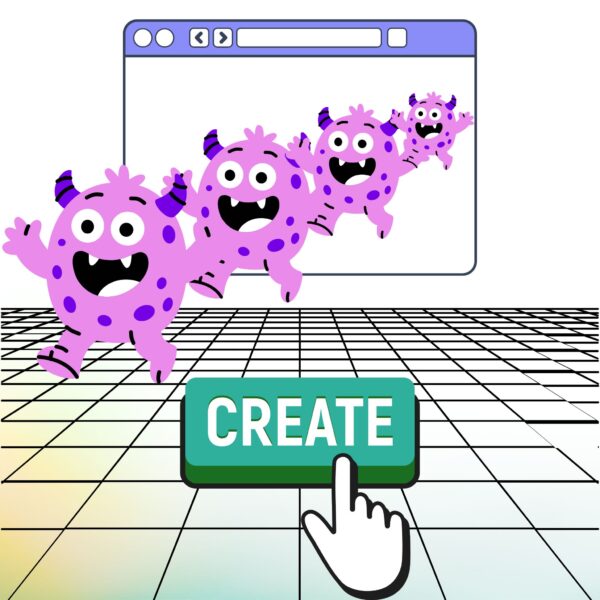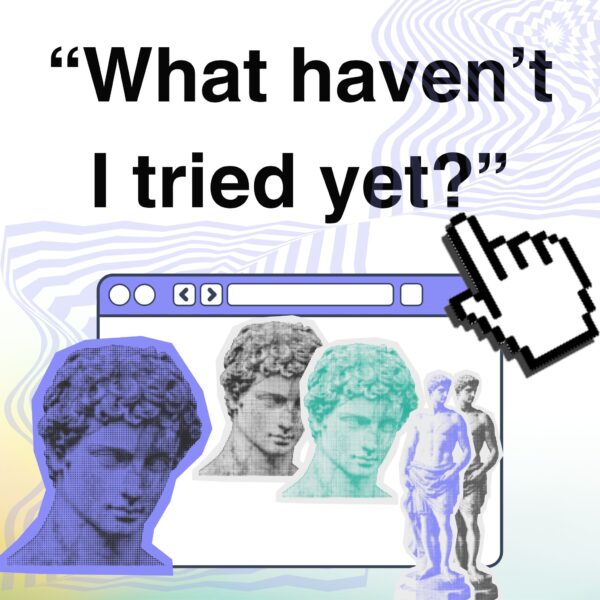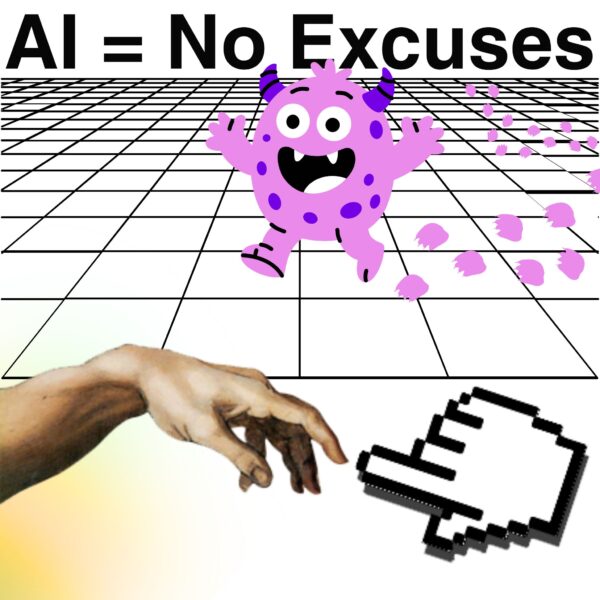AI content creation isn’t just a buzzword anymore—it’s the new normal. We’re entering an era where nearly anyone with a story or idea now has the means to produce high-quality content, and that’s something to get genuinely excited about. Whether you’re a solo creator, a scrappy startup, or part of a Fortune 500, AI and creativity are now the secret sauce-mix that helps your ideas leap from napkin sketches to viral campaigns. It’s not just about efficiency—it’s about opening the gates to more competition, more diverse voices, and a true explosion of human creativity.
But how do you actually use it without losing your creative voice? Let’s break it down, with real stories, honest advice, and a clear-eyed look at what works (and what doesn’t).
Want to skip this content-specific blog and go straight to AI Tools for Marketing?

How AI Content Creation Is Transforming Workflows
If you’ve ever spent hours fiddling with drafts, tweaking slides, or staring down a blinking cursor, AI’s arrival probably feels like a lifesaver. But it’s more than just a time-saver—it’s a total shift in how creative work gets done. AI for creators should feel like having a team of three (very smart) people working for you but that require structured prompts, enough context, and sometimes very literal explanations or feedback.
From Experiments to Essential Infrastructure
When I first dabbled with AI, it felt a bit like magic—and a bit like a gamble. I remember feeding a clunky prompt into an early content tool and getting back something… well, let’s say “quirky” is the polite word. Fast-forward to today: my marketing friends run entire campaigns with AI-generated drafts, and my designer buddy jokes he spends more time curating than creating from scratch. The numbers back this up: the generative AI market is predicted to skyrocket from $49.3 billion in 2024 to $2.4 trillion by 2035. That’s not just hype—it’s a tidal wave. What felt like a “game” 3 years ago is changing the way the world operates – specially for creators.
AI as the New “Electricity” for Creators
Imagine if every creative professional had a silent, tireless assistant—one that works 24/7, never complains, and learns faster than anyone you know. That’s what AI is becoming. Like electricity a century ago, it’s fading into the background, quietly powering everything from brainstorming sessions to final edits. You don’t marvel at light switches anymore; soon, you won’t marvel at AI either. You’ll just expect it to be there, making your creative life easier.
Core Technologies Behind AI Content Creation
Understanding the tech isn’t just for engineers or AI-trained users. If you want to get the most out of AI, you need a sense of what’s possible—and where you’ll still need to steer the ship. But the technology is already out there and it’s very accessible if you do your research.
Benchmarking Progress—What Modern AI Models Can (and Cannot) Do
Here’s the truth: AI can write an email, suggest catchy headlines, and even whip up a passable blog post in seconds. But ask it to capture the soul of your brand, or explain your weird inside joke? Not so much. LLMs (think GPT, Claude, Gemini) and diffusion models are amazing at churning out content that sounds plausible.
Still, when you need deep research, a truly original voice, or nuanced storytelling, you’ll want to roll up your sleeves and co-create. I’ve found that the best use is letting AI handle the grunt work—summaries, outlines, first drafts, replicas, fusions—so I can focus on the stuff that actually moves people.

Specialized Tools for Creators and Enterprises
Let’s get specific. Pictory AI is is the go-to for turning hour-long webinars into bite-sized video gems for social. Online reviews swear by Rytr for quick content generation and for improving the content you already write. Though the review also admits the following:
“It’s not quite on par with content written by a real human (there are some grammatical errors and issues with repetition), but it’s certainly not useless gibberish either. It’s at least halfway there.”
Fiction writers are raving about Sudowrite’s quirky prompts, describing abilities, and brainstorming feature. And over in the data world, a colleague at a fintech startup uses Google Looker AI to pull insights from massive datasets, chatting with dashboards like they’re people. It’s not about finding a magic bullet—it’s about picking the right tool for each job.
When it comes to marketing presentations, social posts, case studies, or even building full websites, Gamma AI lets you generate polished, on-brand collateral from a simple prompt—no design skills needed. Gamma streamlines the creation process so you can spend less time on formatting and more time on what matters—strategy, storytelling, and results. If you want to speed up content creation of: strategy decks, social media posts, case studies, and even websites; without sacrificing quality, Gamma is a top choice for teams.
AI Video Generation
Curious how fast AI video generation is evolving? One of the biggest forms of content right now and the YouTube video “The Current State of AI Video Generation 2025” breaks it down with real demos and honest commentary. In just a year, AI tools like LTX Studio, Sora, and Google’s new models have gone from glitchy, obvious fakes to nearly real-time, ultra-realistic video creation.
Key takeaways from the video:
- Speed leap: Tools like LTX Studio now generate 1 second of video per 1 second of processing on top GPUs—last year, that took 20 minutes.
- Realism surge: AI can now simulate lifelike physics, natural camera work, and background details so convincing you’ll need a double-take.
- Challenges remain: Most cutting-edge tools need powerful hardware or are closed-source, and the rise in realism brings deepfake concerns and ethical questions.
Watch the full video here:
Don’t Let Your Ideas Die
Most of us have more ideas than time, and our “drafts” folder is a graveyard of good intentions. Don’t let your best thoughts gather dust—give them a chance to grow. Whether you’re pitching internally or sharing with a client, you don’t need hours to pull things together anymore. Now, you can help people visualize your concept on the spot—right in the middle of a conversation. Even a messy brainstorm might be the start of something great.
What is Aurora Slides?
Here’s how it works: dump your unstructured data, messy notes, scattered meeting transcripts, or half-finished bullet points into Aurora Slides. This AI Deck Builder organizes your thoughts, crafts a narrative, and slaps on a gorgeous template. I tried it for a client pitch last month—what would have taken me a full Saturday turned into a polished deck in less than an hour. The real kicker? I didn’t have to fiddle with fonts or stress about color palettes.
(Imagine: your ideas, suddenly looking like they belong at a TED Talk.)
Key Features and Benefits for Content Creators
- AI-powered everything: From rough ideas to presentation-ready decks, the AI does the heavy lifting.
- Designer templates: No more PowerPoint purgatory.
- Smart mapping: The AI “gets” your story arc and builds slides that make sense.
- Conversational editing: Just type, “Make this more visual,” and the AI responds—no jargon required.
- Team-friendly: Share, control access, publish links—collaboration without chaos.
- Real-time feedback: See changes instantly, so you’re never second-guessing.
- Personalized output: Tailor the tone, visuals, and structure to your audience.
Pro tip: If you’re new to AI, check out our Mastering AI Adoption Guide—it’ll save you hours of trial and error.

Economic and Legal Realities
Here’s the part nobody likes to talk about: AI is powerful, but it’s not free—and it can get you in hot water if you’re not careful.
The Compute Cost Crisis—Why Scale is Both Opportunity and Challenge
Remember when “the cloud” seemed infinite? Now, the bills are rolling in. Training and running advanced AI models is getting pricier every year—costs are projected to jump 89% between 2023 and 2025. Some companies are spending billions just to keep their models competitive, For us mere mortals, this means picking tools that are efficient, not just flashy. When I switched from a heavyweight video tool to a leaner text-based AI for daily drafts, it cut my costs (and headaches) in half.
Copyright, Authorship & IP—Navigating the Legal Maze
So, you let AI write your whole blog—do you own it? Short answer: not really. The US Copyright Office says only content with “sufficient human authorship” is protected. Case in point: A comic artist lost copyright over AI-generated images but kept it for her story and arrangement. My rule? Always add your own voice, edits, and structure. Make the AI work for you, not the other way around. (Sidebar: If you’re ever in doubt, a quick chat with an IP lawyer is worth its weight in gold.)
The Fair Use Battleground—Landmark Legal Precedents
And then there’s the wild west of training data. When Anthropic settled for $1.5 billion with authors over unauthorized book use every AI company took notice. Some courts say AI training is fair use; others (and the big settlement checks) say, “Maybe not so fast.” My advice: Know where your tools get their data, and don’t trust “free” datasets without doing your homework.
Human-AI Synergy— Not Replacement
The best content I’ve seen lately? It’s not from AI alone—or from humans alone. It’s a dance between the two. And clearly, people are hungry for hacks that unlock true synergy.
Right at the heart of this conversation is a wildly popular Reddit commentary that’s been making the rounds on r/ChatGPTPro (428 upvotes, 70 comments and counting). In the thread, user Illustrious-King8421 shares a prompt and practical framework for generating content with ChatGPT that reads as 100% human—using the “dependency grammar” approach and clever prompt engineering.
The sheer engagement on this post shows just how interested creators are in finding new ways to blend AI’s speed with the unmistakable touch of human creativity.
How to Create 100% Human Written Content with ChatGPT
byu/Illustrious-King8421 inChatGPTPro
This kind of idea trading isn’t just internet noise—it’s proof that the community is actively searching for, sharing, and iterating on ways to make AI work for them, not just as a shortcut, but as a true creative partner. It’s a reminder: with a bit of strategy and experimentation, you can steer generative AI to be a powerful co-writer, without losing your unique voice in the process.
The Cognitive Impact—Collaboration Outperforms Solo Effort
There’s real science behind this: a recent meta-analysis found that humans + GenAI beat human-only teams in creative tasks (g=0.27). My own brainstorming sessions have doubled in productivity since I started using AI, Aurora’s features – specifically, for first drafts and idea dumps. It’s like having a junior partner who never gets tired or bored, but always needs your final say.
The Diversity Dilemma—Avoiding Creative Homogenization
But don’t let the AI take the wheel for too long. The same study showed that AI collaboration can shrink idea diversity (g=−0.86), especially if you rely on it for every draft. I’ve noticed this in my own work—if I’m not careful, every draft starts to sound the same. That’s why I deliberately throw in weird analogies, challenge the AI’s word choices, and ask, “What haven’t I tried yet?” The Copyright Office agrees—the magic is in your “selection and arrangement”.
At the same time, other research shows that high AI exposure can actually boost collective idea diversity, even if it doesn’t make any one person more creative. So, if you’re working in a group or crowdsourcing ideas, a mix of AI input can help shake things up—just don’t lose track of your own unique voice. Keep it weird. Keep it you.

Strategic Recommendations
Since AI isn’t going anywhere, and neither is the need for a human touch. Here’s how I (and plenty of other creators) are making the most of this new era.
Actionable Steps for Creators, Brands, and Policymakers:
- Optimize for efficiency: Don’t just chase the shiniest tool. Try a few, see what fits, and be ready to pivot as new solutions arrive.
- Stay legal: If you’re scaling, invest in legal advice and compliance—it’s cheaper than a lawsuit.
- Curate ruthlessly: Use AI to jumpstart ideas, outlines, and drafts, but always put your personal or brand stamp on the final work.
- Prepare for growth: The AI market is on track to hit $2.4 trillion by 2035. Expect more tools, more competition, and more opportunity for those who adapt quickly.
- Lean into best practices: Use AI for brainstorming, content briefs, outlines, and first drafts, but don’t outsource your critical thinking. AI can help break creative block, accelerate research, and handle data deep dives, freeing you up to focus on storytelling and strategy.
“Instead of staring at a blank page, use AI to generate those initial content concepts to spark your brain into action for ultra creative marketing campaigns… But when it comes to unique, on-brand content that has that wow-factor, you want to work together with AI in the perfect partnership.” — Optimizely: Using AI for Content Creation
The future belongs to those who can blend speed, creativity, and authenticity—sometimes with a little help from their (AI) friends ☺️.
Conclusion
AI is here, it’s powerful, and it’s only getting smarter. But the best results still come from creators who use it as a tool—not a crutch. Embrace the new era, keep your voice strong, and remember: the future of content isn’t just about what you can automate, but what only you can create.
As technology evolves, the real magic happens when we blend human perspective with AI’s capabilities—using automation for the heavy lifting, but letting originality and experience guide the way. The most compelling work will always be the product of curiosity, experimentation, and genuine insight.
So, experiment boldly, stay curious, and keep pushing the boundaries. The tools will keep changing, but your unique voice is irreplaceable.

Ready to see for yourself? Try Aurora for your next big idea, and check out our Learning Vault to learn more about artificial intelligence content creation and AI pitch deck generation.
Frequently Asked Questions (FAQs)
What is AI content creation?
A: It’s using AI tools or AI for teams, to generate, edit, or enhance everything from blog posts to videos and presentations. Think digital assistant, not digital replacement.
How do I use AI for content creation?
A: Start with a pain point—drafting, editing, repurposing, deck writing—and try a tool that specializes in it. Don’t be afraid to experiment.
Are there legal risks with AI-generated content?
A: Yep. Copyright, data sources, and fair use are all moving targets. Always add your own voice and check your sources.
Is AI replacing human creativity?
A: Not a chance. The best stuff comes from AI and humans working together—and humans making the final call.
What makes Aurora Slides different?
A: It’s built for speed and clarity—turning chaos into beautiful, shareable decks in minutes, without any design headaches. For example, you can copy and paste everything you know about your competitors, combine it with your own notes, and instantly prompt Aurora to generate a complete competitor analysis pitch deck in just minutes.
What if I’m worried I’m not using AI the “right” way for content creation?
A: You’re not alone—lots of people feel unsure at first. The good news? There’s no single “right” way. Start small, experiment with different tools (Aurora offers a free trial here), and focus on solving your own pain points. Remember, AI is meant to help you, not replace you. Every creator’s process is unique—give yourself permission to learn as you go.
